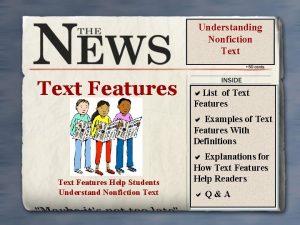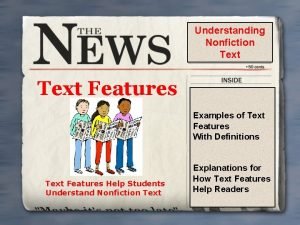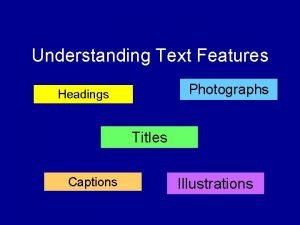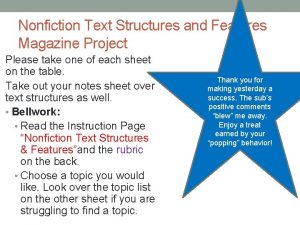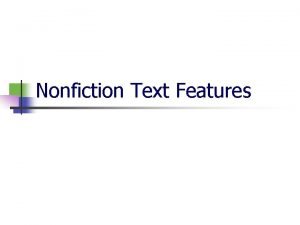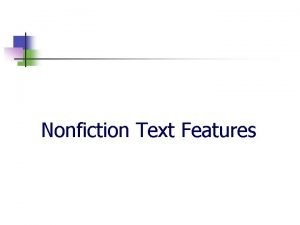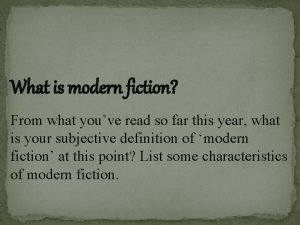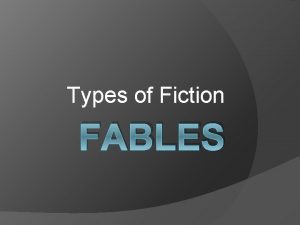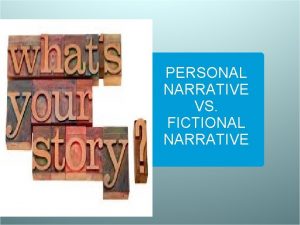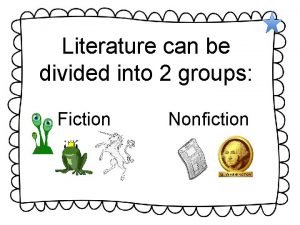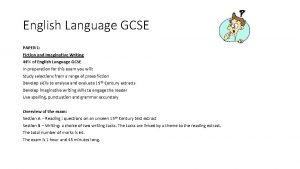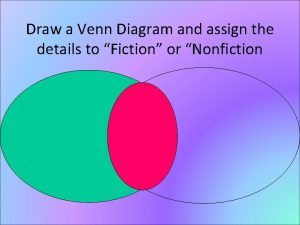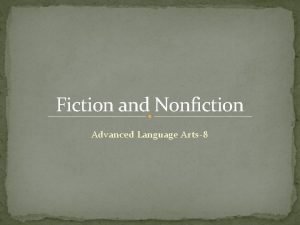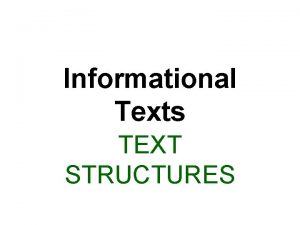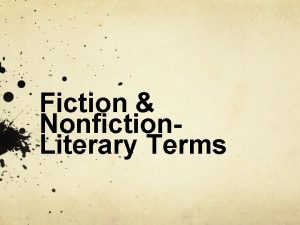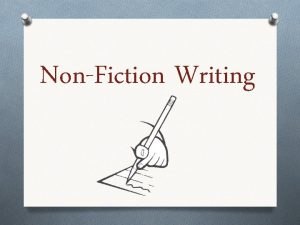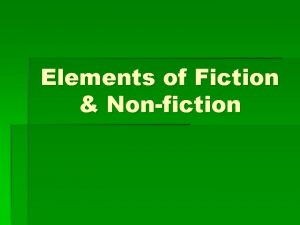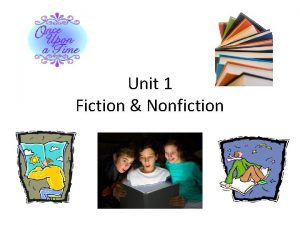Understanding Fiction Nonfiction Text Features Identify text features

















- Slides: 17

Understanding Fiction & Nonfiction Text Features Identify text features. Support text info. Using text features. Text Features Help Students Understand Nonfiction Text

What are text features? • help reader better understand what was read. • provide info that may not be in the text itself. • can be found in textbooks, articles, literature, newspapers, reports, web pages, and other forms of fiction and nonfiction.

The information about where animals live would be found on page 3 in Animal Habitats. 1. Table of Contents Chapter 1: All About Animals Animal Adaptations ……. . Page 1 Animal Food………. . Page 2 Animal Habitats. ………. . Page 3 Animal Homes. . ………. …Page 4 Chapter 2: All About Plants Photosynthesis …………. Page 5 Types of Plants …………. Page 6 Where would a reader find information about where an animal lives? • lists major parts of book along with page #s

The reader could find information about acid rain on pages 396 – 397. 2. Index A Abu Simbel, temple of, p 73 Acadia, Canada, 212 -213 Acid rain, 396, c 396 -c 397, 396 -397 Animal Adaptations p 1 Animal Food p 2 Animal Habitats p 3 Animal Homes p 5 Where would a reader find information in the text about acid rain? • alphabetic al listing of key terms and page #s at the end of a text

The reader would understand animal adaptations better because the glossary tells them what it means to adapt. 3. Glossary A Acid rain (AS ihd rayn) rain that carries certain kind of pollution. Adapt (uh DAPT) to change in order to survive in new environments How would the glossary help the reader understand text about animal adaptations? • list of key terms and definitions in alphabetical order at the end • bolded

The titles all talk about space so the articles are all about space. 4. Headings • show the main idea of the text What do the headings of the articles in these newspapers tell you? • top of page

Where would the reader look to find out about a fire ant? A fire ant is a kind of ant so the reader would look in Types of Ants. 5. Subheadings Helpful Ants • divide the text into Although ants are frustrating when sections they get in homes, ants do help the environment. They help control the population of damaging pests such as • tell the main idea of each section of text termites. Types of Ants • use large or bold Types of ants include fire ants, which words cause a painful sting, and carpenter ants, which damage wood structures while nest building. Other types of ants include honey, pharaoh, house, Argentine, and the thief ant.

Where would the reader look to find out about a fire ant? A fire ant is a kind of ant so the reader would look in Types of Ants. 6. Bullet Points / Numbers • point readers to important info.

The textbox contains the mystery to help create interest for the reader. 7. Sidebar • interesting facts or important info not already in One of the textboxes above asks the text the reader to solve a mystery about a Tasmanian Devil. Why would he include this mystery?

The table would help the reader understand where and how often volcanoes erupt. 8. Graphics / 9. Captions • photos, designs, illustrations, diagrams, charts, graphs, etc. that support the text • make data easier to read and understand How would a table about volcano eruptions help the reader understand volcanoes? • captions underneath explain the graphic

This forward may lend more authority to the text 10. Foreword • book intro. written by someone other than the author • before the main text

Prologues and prefaces add interest to the text 11. Prologue / 12. Preface • both written by author • prologue tells of events occurring before the main story begins – fiction • preface gives interesting facts or background info. before the main text – nonfiction

13. Footnotes / 14. Endnotes • provide further explanation • footnotes – bottom of page • end notes – end of document

15. Bibliography • alphabetical list at the end of books, articles, etc. used as references

16. Afterword / 17. Epilogue • come at the end of main text to close • afterword – additional info. • details: – nonfiction • Images may be subject to copyright. • epilogue – tells what happened to characters after story – fiction

Find an article and find an example of each text feature. Explain how each example helps you to understand what you read.

QUIZ TOMORROW! Bellwork (2/7/13) • Take out your 17 text feature terms. • Text feature scavenger hunt activity must be completed and turned in by the end of the period today.
 List of text features in nonfiction
List of text features in nonfiction What are text features examples
What are text features examples Using illustrations to understand text powerpoint
Using illustrations to understand text powerpoint Nonfiction text features project
Nonfiction text features project Parts of nonfiction text
Parts of nonfiction text Sidebar in nonfiction text
Sidebar in nonfiction text 8.04 modern fiction and nonfiction
8.04 modern fiction and nonfiction Fable fiction or nonfiction
Fable fiction or nonfiction Personal narrative vs narrative
Personal narrative vs narrative Fiction vs nonfiction
Fiction vs nonfiction Is english language paper 1 fiction or nonfiction
Is english language paper 1 fiction or nonfiction Elements of nonfiction definition
Elements of nonfiction definition Fiction and nonfiction venn diagram
Fiction and nonfiction venn diagram Elements of nonfiction quiz
Elements of nonfiction quiz Elements of fiction and nonfiction
Elements of fiction and nonfiction Text _____ in a nonfiction text is its organization.
Text _____ in a nonfiction text is its organization. Genre of speculative fiction
Genre of speculative fiction Contemporary realism literature
Contemporary realism literature
